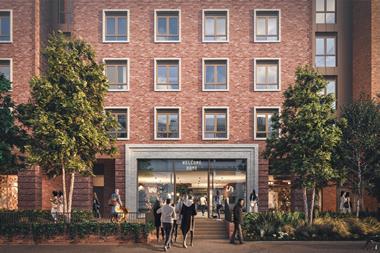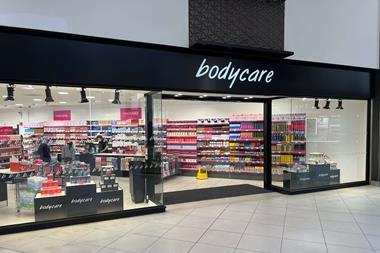Britons have long dreamt about having the same style of living they experience on their holidays to the Mediterranean. But dining in piazzas or enjoying a glass of wine on a bistro balcony has never been much of a reality in the UK.
Yet, while many factors – not least the weather – stop British town centres competing with the Med, town-centre living and leisure are experiencing the first wave of a renaissance.
Government initiatives introduced more than 10 years ago, including the Planning Policy Guidance Note 6 (PPG6), have forced development back into town centres and retail is at the heart of the regeneration.
Following the lukewarm reception that often greets Government directives, developers got behind the idea. Mixed retail and residential schemes have started to emerge to fuse the previously separate elements. Pure retail schemes are now the exception – residential elements are now commonplace.
“There’s been a migration back to the city centres,” says Lend Lease Europe deputy chairman Robin Butler. “We are only now starting to get the residential/retail mix right. You’ve got to give the industry credit for conforming to external pressures, but now there’s a lot of good-quality examples of residential/retail schemes that have emerged as a result.”
The stimulus for the latest wave of mixed-use schemes was Government fears that continuing out-of-town development in the same vein would be devastating to the long-term prospects of towns and cities. Initially, central Government and then local authorities, began to look to developers to play their role in the revitalization of urban space, which it feared would become derelict without immediate action.
All change
Many local authorities have taken the lead in the process of spelling out the types of schemes they are looking for and designing and building mixed-use schemes in urban areas, in order to ensure that they comply with central Government directives that have their roots in the PPG6.
“This change in direction [from out-of-town to town centres] has been dictated mainly by developers, as mixed-use schemes enable them to justify land values and create the right density from a site,” explains Savills director Nick Symons. “Also, mixed-use developments are by far the preferred format with planners, in terms of the regeneration of our town centres and the creation of a dynamic and successful business mix.”
The Government’s priorities in encouraging town-centre development also stemmed from the social problems that come with an ailing high street. “Clearly the rationale for mixed-use is illustrated in declining footfall in town centres, as well as in the greater volatility and vulnerability of town centres, relative to shopping centres,” says Diane Wehrle, director of research at consumer trends consultancy Springboard.
She adds: “The relative weakness of their shopping [town centres] means that they are more susceptible to a downturn and are less able to capitalise on an upturn.”
Wehrle points out that the drop in footfall in town centres stems from many factors – out-of-town schemes, the impact of internet shopping and the diversification of food stores into non-food and other services. “Mixed-use creates another reason for customers to visit town centres,” she says.
Many town centres were in desperate need of regeneration. The fervent development of out-of-town schemes over the past 20 years had taken its toll. Along with the choice of retailers that out-of-town parks provided, they also enjoy the added benefit of free parking. Shoppers who battle through traffic congestion to get to a town centre then have to find a parking space and pay for it. It’s easy to see where they prefer to go to an out-of-town centre.
Yet, mixed-use schemes have their own challenges. Mixed-use centres tend to throw up more complex issues than those that are solely retail- or residential-based. The varied nature of the development means that getting planning consent is a more drawn-out process. Retailers can suffer setbacks in terms of opening and the developer has the demands of different types of clients to meet.
Ready-made market
Chris Slamon is manager director of Chetwoods Architects, which has just completed a joint venture between Sainsbury’s and Network Rail to build Brighton New England Quarter, a mixed-use scheme of 247 housing units and 53,000 sq ft (5,000 sq m) of retail space. He explains: “Often in these situations, there’s a planning condition that says a retail development needs to wait until the residential aspect has been completed before it can open. For a retailer, the whole development process therefore takes longer to get through planning because it’s more complicated and it takes longer to build.”
If done properly though, mixed-use schemes in town centres can work well for retailers. Having a captive market on your doorstep is a retailer’s dream. And if the developer has succeeded in attracting the right calibre of resident, the gains can be immense. It’s still early days in the latest wave of developments, but early signs are encouraging for retailers.
“A mixed-use scheme has benefits for both residential and commercial tenants, as the accommodation serves those who live locally and vice versa,” says Redrow Regeneration managing director John Ireland. “Retailers have the assurance that they will always have customers living around them, while residents have the benefit of being able to walk a short distance to get groceries and household items or to see a film.”
O&H’s scheme at Walton-on-Thames in Surrey, successfully marries retail and residential. The Heart houses 227,000 sq ft (21,090 sq m) of retail space below 265 one- and two-bedroom apartments and 14 penthouses in the centre of the town. Among the line-up is a 70,000 sq ft (6,505 sq m) Sainsbury’s, which serves as the scheme’s main food retailer.
Sainsbury’s head of property development Chris Templeman explains that mixed-use can give residents easy access to its stores. “Mixed-use developments, including residential, are not only in-line with planning policy, but ensure that our stores are easily accessible for our customers and colleagues in terms of reducing their need to commute to the store.”
Mixed-use schemes also often house the particular type of resident a retailer wants to attract.
Crosby Lend Lease scheme Clarence Dock in Leeds has opened its doors to residents, but not yet opened its retail phase. The developer claims a recent survey found the residents already occupying most of the 1,100 apartments in the scheme are desirable to retailers. Among the respondents, 60 per cent were aged between 20 and 30 and more than half earned from£20,000 to£30,000. For retailers, having such a large and marketable catchment so close is a potential goldmine.
While nothing is yet signed, Clarence Dock is rumoured to have held talks with retailers including Armani, Replay, All Saints and G-Star.
Brookfield Europe director of retail development Tim Buckley sounds a note of caution about expecting retailers to come flocking if there is a residential area in a scheme though. He believes a residential element does not top a retailer’s requirements list, but rather it will come down to the quality of the offer made by the developer, as well as the local catchment. “It will be complementary to their thinking, but it won’t make the difference between whether or not they sign”, he says. Although he adds: “Some of the mixed-use projects that have been put together are world class.”
As with any development, there are also some potential snags to mixed-use. The benefits of having a ready-made catchment on your doorstep can’t be ignored, but that in itself throws up some unique problems. Enjoying a romantic dinner for two on your apartment balcony, for example, could be ruined by a lorry delivering a truckload of fish to the supermarket below.
Another problem is the added servicing, such as cleaning, sanitation and general upkeep, which mixed-use schemes need. “Servicing is something that needs to be looked at,” said Markham Vaughan Gillingham director Woody Bruce. He adds: “One of the major issues will be service complaints from residents and retailers could be left to pick up the pieces. It all boils down to good design and good processes being put in place before a centre is built.”
Teething problems aside, Britain’s town centres seem set to benefit from mixed-use schemes. It fits with planning policy on regeneration and transport, and creates new opportunities for retailers.
One cloud on the horizon, though, is the tough economic climate. The housing market has suffered a downturn and there is a risk that any new apartments being built will go unsold. Trading in a half empty scheme without a captive catchment is no good to anyone.
Yet, if developers can make mixed-use enticing to both retail and residential and marry the two together, then it can work.
Mixed-use schemes may not lead to Britons sitting around in cafés at 11 o’clock in the evening, but they do offer retailers the option of trading in a development that could potentially provide a ready-made, on-site market.


























No comments yet